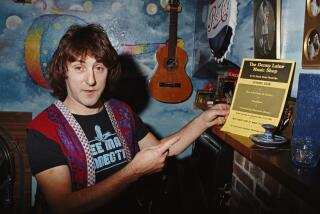Celebrating Hamptonâs Incredible Vibe
When Lionel Hampton gave his last performance in Los Angeles--a 90th birthday celebration in 1998 at the Ford Amphitheatre--his indomitable spirit was still willing, even though his familiar, high-spirited physical vigor had been dimmed by a series of strokes. But no matter. Though he had to remain seated to play his vibes and was clearly incapable of whipping off the lightning-fast runs that had been his stock in trade for nearly seven decades, his remarkable sense of swing was still present in every modest note he played.
Someone once said that Louis Armstrong only had to play one note to define what the sense of swing was all about. The crispness of his articulation, the urgency of the tone, the anticipatory feeling of propulsion with which he finished the note--they all contributed to the lift and movement essential to the almost indescribable feeling we know as swing.
Exactly the same can be said of Hampton, who died Saturday in New York City at 94. His mastery of swing was never more apparent than it was on that cool October night in 1998. Distressing as it was to see him debilitated, one knew that so long as he could hold a vibes mallet, the resulting sound would be well worth hearing--as it always had been, from the first day in 1930 when Hampton played the instrument, virtually on the spot, in a Louis Armstrong recording session.
As a drummer, Hampton knew mallet instruments such as the vibraphone have limited resources for tonal variation. Their effectiveness lies in the articulation with which they are played, as well as the inherent drive that gifted artists bring to the instrument.
Thatâs not easy. The best evidence of its difficulty is in the relatively small list of high-level jazz vibists who have evolved over the century-long history of jazz. Mention Hampton, Red Norvo, Milt Jackson, Terry Gibbs, Bobby Hutcherson and Stefon Harris, and youâve covered most of the major names. There have been others, such as Cal Tjader and Roy Ayers, but only a few artists who define the genre.
It didnât matter whether Hampton was playing within the Swiss-watch perfection of a Benny Goodman small ensemble, energetically leading his own roaring big band--an artistic incubator for players ranging from Clifford Brown and Dexter Gordon to Quincy Jones and Betty Carter--or simply reliving his past hits for audiences who couldnât get enough of âFlyinâ Homeâ or âHampâs Boogie Woogie.â The results were always the same: an incomparable blend of accessibility and artistry.
Hampton was a defining voice for a generation of musicians who understood that it was possible to entertain without sacrificing oneâs quest for inventiveness. And he did so with consummate skill.
It was typical of Hampton that, when I spoke with him prior to the 1998 performance, he preferred to concentrate upon the hot band he was bringing to the Ford, enthusiastically lauding its âgreat trumpet section,â its âgreat high-note lead trumpet player,â its âgreat tenor player.â
âBelieve me,â he said, âitâll still have all the juice.â
Left behind in his exhilaration over the music was any sense of remorse over the strokes he had recently suffered, or the catastrophic New York City apartment fire that had destroyed so many of his treasured possessions.
In addition to the dozens of marvelous recorded performances, that is the Lionel Hampton I prefer to remember: the Hampton who was still capable and still captivated by the music in the final stages of his life; the Hampton who was always thrilled by new players, new music and new possibilities; the Hampton who never stopped celebrating the joy and the wonder of making jazz.
More to Read
The biggest entertainment stories
Get our big stories about Hollywood, film, television, music, arts, culture and more right in your inbox as soon as they publish.
You may occasionally receive promotional content from the Los Angeles Times.










